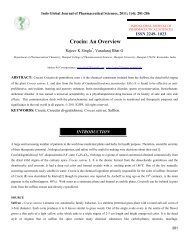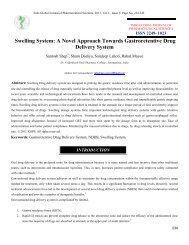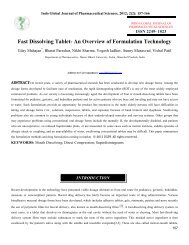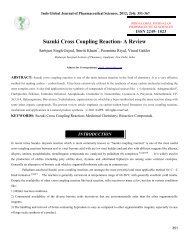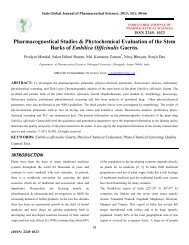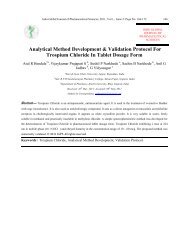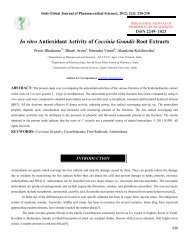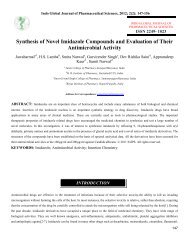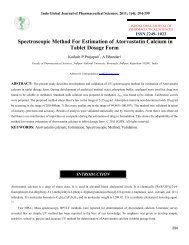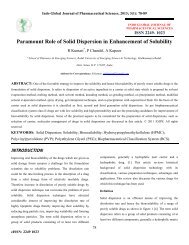Formulation, Development & Characterization of Ofloxacin ...
Formulation, Development & Characterization of Ofloxacin ...
Formulation, Development & Characterization of Ofloxacin ...
You also want an ePaper? Increase the reach of your titles
YUMPU automatically turns print PDFs into web optimized ePapers that Google loves.
Indo Global Journal <strong>of</strong> Pharmaceutical Sciences, 2012; 2(2): 130-141overall therapy. Many drugs require controlled administration into certain conditioned patients such as patient who are undergoingdialysis for renal impairment or for patient who has are hepatically insufficient. This is because the uncontrolled release can render thedrug to be toxic and further harmful to other organs. <strong>Ofloxacin</strong> is a synthetic fluorinated carboxyquinolone that has a broad spectrum<strong>of</strong> activity against both gram-negative and gram-positive bacteria [1]. It is indicated for uncomplicated skin infections, complicatedurinary tract infection, respiratory tract infections and some sexually transmitted diseases [2]. Normal dosage regimen varies from200-600 mg administered twice or thrice a day, depending on severity <strong>of</strong> infection. Biological half-life <strong>of</strong> drug is from 5-6 hrs [3]. Asit requires multiple dosing to obtain the required therapeutic doses and due to the established warnings <strong>of</strong> its dangerous adverseeffects, this drug has been chosen to be the model <strong>of</strong> our study. The formulation <strong>of</strong> sustained release dosage form through the design<strong>of</strong> <strong>Ofloxacin</strong> microspheres could also potentiate the drug’s ability to reduce the development <strong>of</strong> drug resistant bacteria. The coatmaterial can be <strong>of</strong> various types ranging from natural polymers, such as albumin, gelatin [4] chitosan and synthetics such poly (vinylalcohol), poly (Iactide-co-glycolide) and a combination <strong>of</strong> two polymers such as chitosan-sodium CMC, alginate-chitosan [5] oralginate-gelatin. The current method that is being practiced in this study is done with natural polymers. The main advantages <strong>of</strong>natural polymers are that they are biocompatible, biodegradable and produce no systemic toxicity on administration [6].The method isalso easier, convenient, and cost effective, less time consuming and expected to produces an efficient release rate. The polymer that isbeing used in this study is chitosan and co-polymers are gelatin [7] and sodium alginate [8].MATERIALS & METHODSMaterials<strong>Ofloxacin</strong> was obtained as gift sample from Reachem Laboratory chemicals, pvt ltd, Chennai, India. Chitosan, sodium alginate andgelatin was purchased from R &M Chemicals, Essex, UK. All other reagents used were <strong>of</strong> analytical grade.Preparation <strong>of</strong> <strong>Ofloxacin</strong> MicrospheresChitosan-coated alginate-gelatin microspheres <strong>of</strong> <strong>Ofloxacin</strong> were prepared by non-ionic crosslinking method. As presented in Table4.1, five different formulations were prepared with respective quantities <strong>of</strong> the polymer (Chitosan) with co polymer (Gelatin) andsodium alginate with drug in different drug-polymer ratio <strong>of</strong> 1:0.5, 1:0.75 and 1:1. Sodium alginate was dissolved in a 25 ml <strong>of</strong>preheated distilled water <strong>of</strong> about 55°C. Chitosan dissolved in 1-2% <strong>of</strong> acetic acid solution was taken and to that, 100 mg <strong>of</strong> powdered<strong>Ofloxacin</strong> was added and were placed on the sonicator (Elma S80 H Elmasonic) for approximately 15 min with a light stirringoccasionally. This was to ensure that the drug is equally dispersed on the aqueous medium and to remove any air bubbles the resultedfrom the stirring by glass rod. While the solution was still on the sonicator, 2-2.5% <strong>of</strong> gelatin was added and continuously sonicateduntil the gelatin forms a mixture <strong>of</strong> uniform dispersion. By using a 20 gauge sized needle, the drug-polymer mixture was slowly addeddrop wise into 1% <strong>of</strong> Calcium Chloride solution. The microspheres formed are let stand for 10 min before filtering it with Whatmannfilter paper using a vacuum pump. The filtered microspheres were dried at room temperature for 48 hrs as in Table 1.Evaluation and <strong>Characterization</strong> <strong>of</strong> MicrospheresDrug ContentTo prepare a standard solution, 50 mg <strong>of</strong> the <strong>Ofloxacin</strong> drug was dissolved in 50 ml <strong>of</strong> phosphate buffer solution <strong>of</strong> pH 7.4. From thesolution, 1 ml was withdrawn and diluted with 100 ml <strong>of</strong> phosphate buffer.131




